Fig. 15.1.
Borders of the inguinal canal (from Wagner et al. [4], with kind permission © McGraw-Hill Education).
Complications
Complications of inguinal herniorrhaphy are multifold. Intraoperative complications are noted at less than 2 %. Postoperative complications are as high as nearly 20 %, including urinary retention, urinary tract infection, orchitis, surgical site infection, neuralgia, or (rarely) life-threatening complications. Long-term complications are nearly 18 %, and may include seroma formation, chronic orchitis, chronic infection, chronic pain, or recurrence [5].
Chronic Post-herniorrhaphy Groin Pain: Definition
Chronic post-herniorrhaphy groin pain is defined as pain lasting >3 months following hernia repair. Studies show an incidence of chronic pain of 11 % [6]. Inguinodynia can be neuropathic or non-neuropathic. Neuropathic pain can be caused by nerve entrapment, stretching of nerves, and partial or complete division of nerves with neuroma formation. The three nerves most commonly involved are the iliohypogastric nerve, the ilioinguinal nerve, and the genital branch of the genitofemoral nerve. Non-neuropathic causes include periosteal reaction and mechanical pressure caused by folded mesh [7].
Treatments
Treatments for chronic groin pain include nonoperative interventions such as pain control with or without narcotic pain medications, and injection-based therapies such as nerve blocks and radiofrequency neurolysis. Additionally, operative intervention has been used for refractory chronic groin pain. Surgical treatments include single nerve resection, triple neurectomy, and mesh removal.
Nonsteroidal anti-inflammatory agents are often first-line therapy for chronic groin pain. NSAIDs are nonselective COX inhibitors that decrease inflammation. These are particularly helpful in the postoperative period. Scheduled NSAIDs for 2 weeks improved pain symptoms in 25 % of patients with chronic groin pain after inguinal hernia repair in one study [7]. For moderate to severe chronic groin pain, opioid analgesia may be required. Treatment with this regimen is recommended for a minority of patients and in conjunction with a pain specialist. Antidepressants are another first-line therapy used for chronic neuropathic pain. At low doses, antidepressants work by blocking neurotransmitter uptake at the presynaptic terminal and function as an analgesic. Tricyclic antidepressants followed by SSRIs are the most commonly used antidepressants. Antiepileptic drugs such as pregabalin, gabapentin, and topiramate have been used for neuropathic pain. The mechanism of action is by modulation of calcium and sodium channels that stabilize neurons involved in rapid firing, thus affecting the intensity of neuropathic pain [8]. However, there are few studies that investigate the efficacy of these treatment modalities for inguinodynia following hernia repair.
Injection-based therapies are another treatment alternative for chronic groin pain following inguinal hernia repair. Multiple studies have been performed looking at the effect of nerve blocks with local anesthetics, often under ultrasound guidance. In a single study, 43 subjects were evaluated for chronic moderate to severe inguinal pain status post open hernia repair. Each was given an ilioinguinal and/or iliohypogastric nerve block with a long-acting local anesthetic (bupivacaine) and a corticosteroid (triamcinolonacetonide). There was an average of two injections per subject. Post-procedure, 32–55 % of subjects reported resolution of their moderate to severe neuropathic pain after 20 months [9]. Other studies have demonstrated patients receiving at least temporary relief from nerve blocks with local anesthetic. Ilioinguinal or iliohypogastric nerve blocks can be an effective treatment modality for chronic groin pain, though multiple treatments may be required. Long-term success of injection-based therapies is still unclear. This treatment is often used for diagnosis of affected nerve and prior to surgical intervention.
Radiofrequency neurolysis (RFN) has become a more common procedure in interventional pain management used for chronic inguinodynia. It has been shown to have some longer lasting pain relief in patients with refractory inguinal neuralgia. Although evidence is limited, one small retrospective review evaluated 42 patients and compared radiofrequency ablation to local infiltrative therapy. RFN showed longer lasting pain relief, with the mean duration of pain relief 12.5 months versus 1.6 months compared to an injection-based therapy control group. Patients required from 1 to 3 radiofrequency neurolysis procedures. Local nerve infiltration may be used to aid the identification of inguinal neuralgia and which nerve is affected prior to RFN treatments. The use of this therapy has been limited secondary to the need for extensive knowledge of the inguinal anatomy and expertise in the technology required to perform this procedure, found predominantly in pain management specialists and radiologists (Fig. 15.2) [4, 10, 11].
Surgical interventions have been reserved for patients with severe chronic inguinal neuropathic pain who have been refractory to nonoperative management. Identification of the involved nerve is often performed using local infiltration. There is no gold standard operative intervention for chronic inguinal pain. Mesh and suture removal, resection of a single nerve, and triple neurectomy have all been proposed as potential treatments. Some studies even advocate routine preventive resection of the ilioinguinal nerve at the time of the original hernia repair.

Full access? Get Clinical Tree






